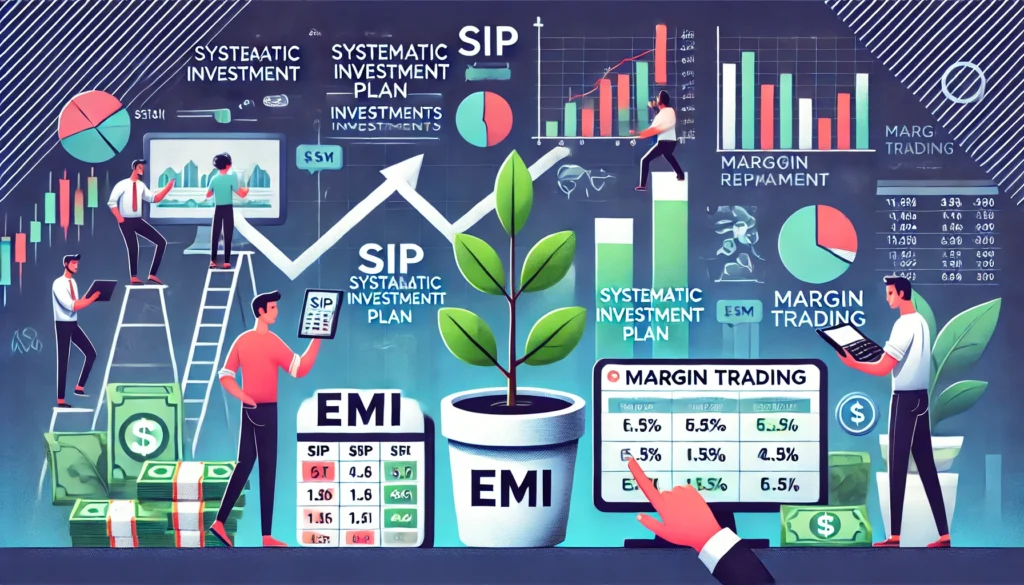The landscape of stock market investing has evolved dramatically, introducing innovative ways for investors to participate in wealth creation. Among these developments, EMI-based investing stands out as a revolutionary approach that’s reshaping how individuals engage with the market.

Table of Contents
Demystifying EMI in Stock Market Investments
Breaking Down EMI: More Than Just Loan Payments
Equated Monthly Installments (EMIs) have transcended their traditional association with loan repayments to become a powerful investment tool. In the context of stock markets, EMIs represent a structured approach to building wealth through consistent, periodic investments. Unlike conventional loan EMIs where money flows outward, stock market EMIs channel funds into potentially appreciating assets, creating a pathway to wealth accumulation.
Why Investors Are Turning to EMI-Based Stock Investments
The paradigm shift towards EMI-based investing stems from its inherent ability to mitigate psychological barriers to market participation. By breaking down larger investment amounts into manageable monthly commitments, investors can participate in the market’s growth potential without straining their finances. This democratization of stock market investing has opened doors for a new generation of investors who prioritize financial discipline and systematic wealth creation.
Systematic Investment Plans (SIPs): Your Stock Market EMI Partner
The Magic Behind SIPs Regular Investment Pattern
Systematic Investment Plans represent the most structured implementation of the EMI concept in stock markets. These plans work on the principle of periodic investing, where a fixed amount is automatically invested at predetermined intervals. This automation eliminates emotional decision-making and enforces investment discipline.
How SIPs Turn Market Volatility into Your Advantage
Market volatility, often viewed as a deterrent, becomes an ally through SIP investing. When markets decline, your fixed EMI amount buys more units, and when markets rise, your existing investments gain value. This mechanical approach helps navigate market cycles effectively.
Rupee Cost Averaging: Making Every EMI Work Harder
Through rupee cost averaging, each EMI payment potentially secures more shares during market downturns and fewer during upswings, naturally implementing a “buy low” strategy. This mathematical advantage can significantly impact long-term returns.
Getting Started with Stock Market EMI
Setting Up Your First SIP
Initiating your stock market EMI journey requires careful consideration of various factors. First, select a reputable broker or mutual fund platform that aligns with your investment goals. Ensure the platform offers robust auto-debit facilities and transparent tracking mechanisms.
Choosing Between Monthly, Weekly, and Quarterly Payments
Investment frequency plays a crucial role in portfolio performance. Monthly investments often provide the optimal balance between maintaining liquidity and capturing market opportunities. However, weekly SIPs might suit those seeking more granular market participation, while quarterly options could work for individuals with irregular income patterns.
Calculating the Right EMI Amount for Your Goals
Your EMI amount should reflect a balance between your financial goals and current capabilities. Consider factors like investment horizon, expected returns, and inflation when determining your monthly commitment. A general guideline suggests investing 20-30% of your disposable income through EMIs.
Future of EMI-Based Stock Investments
Emerging Technologies in EMI Processing
Emerging technologies like AI, blockchain, and digital payment systems are revolutionizing EMI processing by making it more secure, efficient, and personalized. AI enables accurate credit risk assessments, while blockchain ensures transparent and tamper-proof transactions. Additionally, mobile banking apps and BNPL platforms simplify EMI payments, offering real-time tracking and seamless integration for a better user experience.
New Investment Products and EMI Options
Financial institutions are introducing innovative investment products with flexible EMI options, making investments more accessible. Products like Systematic Investment Plans (SIPs) in mutual funds, Real Estate EMIs, and gold-based schemes allow individuals to invest in small, regular installments. These options cater to diverse financial goals, combining affordability with long-term wealth creation.
Regulatory Changes and Their Impact
Recent regulatory changes in financial markets, such as stricter loan eligibility criteria and caps on interest rates, are reshaping EMI structures. These reforms aim to protect borrowers from excessive debt while promoting transparency in lending practices. The changes have encouraged financial institutions to adopt more customer-centric approaches, improving access to fair and flexible EMI options.
Making Your EMI Investment Decision
Evaluating Your Financial Readiness
Before embarking on your EMI investment journey, assess your financial foundation. Ensure you have adequate emergency funds and insurance coverage. Your EMI commitments should complement, not compromise, your overall financial stability.
Creating Your Personal EMI Investment Strategy
Develop a customized strategy that aligns with your risk tolerance, investment horizon, and financial goals. Consider starting with blue-chip stocks or diversified mutual funds through SIPs before exploring more sophisticated options.
Taking the First Step: Implementation Guide
- Choose a reliable investment platform
- Complete your KYC requirements
- Set up auto-debit facilities
- Start with a conservative EMI amount
- Monitor and adjust your strategy periodically
Remember, successful EMI-based investing requires patience, discipline, and a long-term perspective. Start your journey with clear goals and stay committed to your investment schedule for optimal results.
Conclusion
In conclusion, the evolving landscape of EMI processing, driven by emerging technologies, innovative investment products, and regulatory changes, is making financial solutions more accessible and customer-focused. These advancements empower individuals to manage their finances effectively, invest strategically, and achieve their goals with greater flexibility and convenience.

